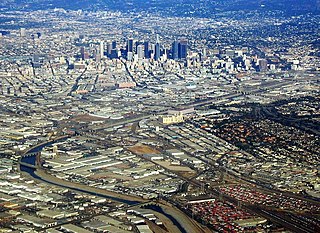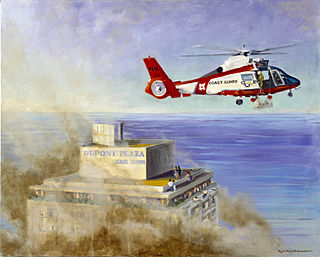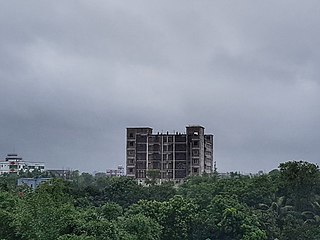
The Triangle Shirtwaist Factory fire in the Greenwich Village neighborhood of Manhattan, New York City, on Saturday, March 25, 1911, was the deadliest industrial disaster in the history of the city, and one of the deadliest in U.S. history. The fire caused the deaths of 146 garment workers – 123 women and girls and 23 men – who died from the fire, smoke inhalation, falling, or jumping to their deaths. Most of the victims were recent Italian or Jewish immigrant women and girls aged 14 to 23; of the victims whose ages are known, the oldest victim was 43-year-old Providenza Panno, and the youngest were 14-year-olds Kate Leone and Rosaria "Sara" Maltese.

On Monday, December 1, 1958, a fire broke out at Our Lady of the Angels School in Chicago, Illinois, shortly before classes were to be dismissed for the day. The fire originated in the basement near the foot of a stairway. The elementary school was operated by the Archdiocese of Chicago and had an enrollment of approximately 1600 students. A total of 92 pupils and 3 nuns ultimately died when smoke, heat, fire, and toxic gases cut off their normal means of egress through corridors and stairways. Many more were injured when they jumped from second-floor windows which, because the building had a raised basement, were nearly as high above ground as a third floor would be on level ground.

The Iroquois Theatre fire was a catastrophic building fire in Chicago, Illinois, that broke out on December 30, 1903 during a performance attended by 1,700 people. The fire caused 602 deaths and 250 non-fatal injuries. It ranks as the worst theater fire in the United States, surpassing the carnage of the Brooklyn Theatre fire of 1876, which claimed at least 278 lives.

Firefighting is a profession aimed at controlling and extinguishing fire. A person who engages in firefighting is known as a firefighter or fireman. Firefighters typically undergo a high degree of technical training. This involves structural firefighting and wildland firefighting. Specialized training includes aircraft firefighting, shipboard firefighting, aerial firefighting, maritime firefighting, and proximity firefighting.

The Garley Building fire took place on 20 November 1996 in the 16-storey Garley commercial building located at 232–240 Nathan Road, Jordan, Hong Kong. The fire caused 41 deaths and 81 injuries. It is considered the worst building fire in Hong Kong during peacetime. The fire damaged the bottom two floors and the top three floors of the building, while the middle floors remained relatively intact.

The Wholesale District or Warehouse District in Downtown Los Angeles, California, has no exact boundaries, but at present it lies along the BNSF and Union Pacific Railroad lines, which run parallel with Alameda Street and the Los Angeles River. Except for some ancillary commercial uses, its cityscape is mostly occupied by warehouses and refrigerated storage facilities. This area is known as Central City North in the Los Angeles city zoning map.
The Kader Toy Factory fire occurred on 10 May 1993 at a factory in Thailand. It is considered the worst industrial factory fire in history, killing 188 persons, and injuring 469. Most of the victims were young female workers from rural families.

The Haunted Castle was a haunted attraction at Six Flags Great Adventure amusement park in Jackson Township, New Jersey. The original Haunted House was built prior to the fall "shoulder season" of 1978 to boost attendance and as a test for building a larger facility the following year. While it was intended that it be open only at night, the popularity of the attraction caused management to open it at the beginning of the day and keep it open until the park closed. At the end of the 1978 season, the attraction was disassembled and sent to Six Flags Over Mid-America, where it would continue to run from 1979 through 1982. The old façade was torn down and Botanical Gardens took its place. A medieval-styled façade was built for the Haunted Castle on the site of the Alpen Blitz across from the Muzik Express.

On New Year's Eve, December 31, 1986, three disgruntled employees at the Dupont Plaza Hotel in San Juan, Puerto Rico, intentionally set a fire. The employees were involved in a labor dispute with the owners. The fire killed between 96 and 98 people and injured 140 others. It is the most catastrophic hotel fire in Puerto Rican history and the second deadliest hotel fire in U.S. territory in history, after the Winecoff Hotel fire in Atlanta in 1946.

On Tuesday, 18 November 1947, a fire engulfed Ballantynes department store in central Christchurch, New Zealand. 41 people died in the fire, all of whom have found themselves trapped by the fire or overcome by smoke, since there was no fire alarm or evacuation plan. It remains the deadliest fire in New Zealand history.

One Meridian Plaza, formerly known as the Fidelity Mutual Life Building, Three Girard Plaza and Three Mellon Bank Center, was a 38-story high-rise office building in Philadelphia, Pennsylvania, United States. The 492-foot (150-meter) tower was designed by Vincent Kling & Associates and completed in 1972.

The Grover Shoe Factory disaster was an industrial explosion, building collapse and fire that killed 58 people and injured 150 when it leveled the R. B. Grover shoe factory in Brockton, Massachusetts on March 20, 1905. Following a boiler explosion, the four-story wooden building collapsed and the ruins burst into flames, incinerating workers trapped in the wreckage.

The Brown Building is a ten-story building that is part of the campus of New York University (NYU), which owns it. It is located at 23–29 Washington Place, between Greene Street and Washington Square East in the Greenwich Village neighborhood of Manhattan, New York City, and is best known as the location of the Triangle Shirtwaist Factory fire of March 25, 1911, which killed 146 people.

Fire dampers are passive fire protection products used in heating, ventilation, and air conditioning (HVAC) ducts to prevent and isolate the spread of fire inside the ductwork through fire-resistance rated walls and floors. Fire/smoke dampers are similar to fire dampers in fire resistance rating, and also prevent the spread of smoke inside the ducts. When a rise in temperature occurs, the fire damper closes, usually activated by a thermal element which melts at temperatures higher than ambient but low enough to indicate the presence of a fire, allowing springs to close the damper blades. Fire dampers can also close following receipt of an electrical signal from a fire alarm system utilising detectors remote from the damper, indicating the sensing of heat or smoke in the building occupied spaces or in the HVAC duct system.

The 2012 Dhaka garment factory fire broke out on 24 November 2012, in the Tazreen Fashion factory in the Ashulia district on the outskirts of Dhaka, Bangladesh. At least 117 people were confirmed dead in the fire, and over 200 were injured, making it the deadliest factory fire in the nation's history. The fire was initially presumed to be caused by an electrical short circuit, but the prime minister, Sheikh Hasina, has since suspected that arson and an act of "sabotage" was involved due to the occurrence of previous comparable events. This fire and others similar to it have led to numerous proposed reforms in workers' rights and safety laws in Bangladesh.

The Royal Jomtien Resort Hotel was a 450-room luxury hotel situated in a 17-story high-rise building on the northern end of Jomtien Beach, 110 kilometres (68 mi) south of Bangkok. At approximately 10:20 local time, 11 July 1997, a fire ignited as a result of a faulty liquid propane gas cylinder in a ground floor buffet of the hotel. The fire burned for 8 to 12 hours across all floors and caused the deaths of at least 91 people and injuries to a further 63.
The Waldbaum's Supermarket Fire was a major American fire on 2 August 1978 in Sheepshead Bay, Brooklyn, New York City that killed six FDNY firefighters. The Waldbaum's store at 2892 Ocean Avenue was undergoing extensive renovations, but was open for customers when the fire broke out.

The Arcadia Hotel fire occurred on December 3, 1913 in a flophouse on the corner of Washington and Laconia Streets in Boston's South End. The fire killed 28 persons, making it the deadliest in Boston at that time, passing the Great Boston Fire of 1872.

















